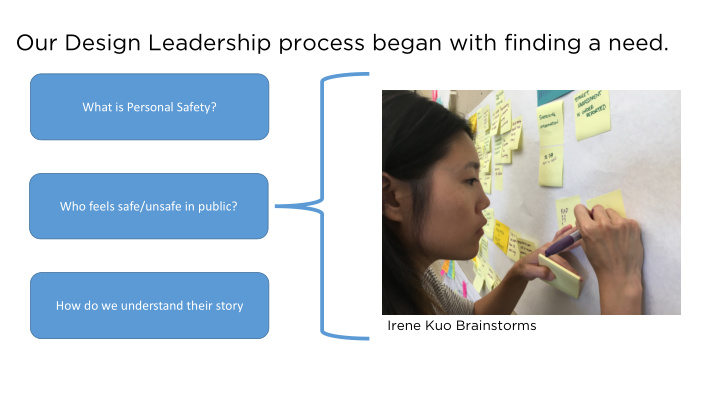



Our Design Leadership process began with finding a need. What is Personal Safety? Who feels safe/unsafe in public? How do we understand their story Irene Kuo Brainstorms
Why do people feel unsafe? Too Broad General Safety Too Broad Safety at Night Verbal Street Harassment Define Problem and Empathize With Stakeholders
Primary Stakeholders Campus Target Local Safety Users Businesses How do we connect the dots?
Stakeholder Disparities Campus Local Safety Businesses “I would see things if they were happening” “Our patrol area is safe” “I can’t think of any specific instances.” “No incidences.” Target Users “I don’t go outside unless I have someone with me.” "I've never been scared ever, like, EVER. But I was scared when I came to Baltimore."
"I was walking home from work right on Cathedral Street and this guy started yelling from his car, "Hey, bitch! Come back here. Let me see what you have under you clothes. I was scared he'd follow me in his car."
Understanding the Experience of Street What is the Story? Harassment
Penny’s Experiences
What is the Cost to Penny?
Smart Ideal Solution Companion Apps Ride App Active User Input Passive User Input Public Transportation Personal Protection Measures Pepper Spray Brute force/Fight with Stick Primitive Aging
Project Appendix: Watch NIVA Product Overview video Interactive App Demo
An Invaluable Public Resource NIVA Data Empowering Users Community Outreach Local Law Enforcement
“We want to go beyond training and public awareness, and develop new solutions offered by information and mobile technologies for women’s safety. The applications are so multi-faceted: these mobile apps, for example, can be used to improve city planning, integrate women’s safety issues in advocacy for infrastructure investment, aid in local governance, and increase citizen participation through real time incident reporting.” - UN Women Safe Cities National Project Officer, Katherine Belen
Recommend
More recommend